#yogic path
Explore tagged Tumblr posts
Text
लय म्हणजे नाश नव्हे, तर एकत्व
ऐकें शक्तीचें तेज लोपे । तेथ देहींचे रूप हारपे ।मग तो डोळियांचि माजि लपे । जगाचिया ।। २९३ ।। ज्ञानेश्वरी अध्याय सहावा ओवीचा अर्थ – अर्जुना, कुंडलिनीचें तेज जेंव्हा लय पावतें तेंव्हा देहाचा आकार नाहीसा होतो, देह वायुरूप बनतो, तो याप्रमाणें सूक्ष्म झाल्यामुळें मग त्या योग्याला लोकांच्या डोळ्यांतच लपतां येते. योगशास्त्र, विशेषतः कुंडलिनी योग, हा एक रहस्यमय आणि अत्यंत सूक्ष्म असा साधनेचा मार्ग आहे.…
#Advaita#Brahman#dissolution#divine light#energy merge#higher consciousness#inner journey#Jnaneshwari#kundalini yoga#Laya#meditation#Moksha#mysticism#non-duality#not destruction#oneness#self-realization#spiritual insight#spiritual transformation#spiritual union#subtle body#surrender#yoga philosophy#yogic path#yogic state#अंतर्मुखता#अद्वैत#आत्मसाक्षात्कार#आत्मस्वरूप#कुंडलिनी योग
0 notes
Text
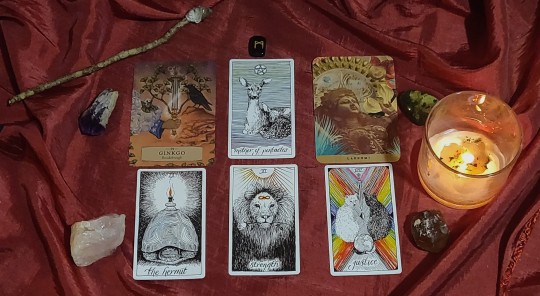
a reading for the collective; for you who see
i get the feeling that a lot of y'all out there need to take some time to nurture yourselves and those you love. there's real internal and external abundance and fulfillment available if self-reflection is practiced and if values of resilience, patience, fairness, and equity are applied not only in how you relate to your internal world of the self but also to the external world of the collective. true wisdom knows silence; true strength knows delicacy; true justice knows difference. put this into practice by calling on your inner earth mother. honor yourself, your family, your colleagues, and your clients as the perfectly flawed and beautiful divine beings of life and experience that we all are; see the change this has on your personal relationships and business partnerships. your behavior can and will act as a catalyst for some long-attempted movement and prosperity, particularly in matters of the home and career.
perhaps handling the tension with your children or in-laws requires you take a humble new perspective—perhaps you've been neglecting to respect the inherent differences in experience you and those around you always have. perhaps work has been really stressful and you are holding out hope for a shiny fresh project, a promotion, or a new job altogether. perhaps you've been exceptionally hard on yourself lately because you haven't been seeing whatever change you want manifesting yet—and maybe it's starting to bleed through to those around you. whatever the case may be, be honest—you are called to honor yourself, your values, and your goals. empathy, gentility, and perseverance will lead to your breakthrough of abundance. and for many of you i suspect the breakthrough will be one of perception—you already are surrounded by and filled with potential.
after all. as within, so without.
#daily tarot#tarot#tarot cards#tarotblr#oracle cards#oracle#norse runes#runes#witchcraft#witch#witchblr#roaen reads#card reading#collective reading#divination#daily divination#wild unknown tarot#herbal astrology oracle#yogic path oracle
16 notes
·
View notes
Text
Choosing a spiritual path is an incredibly personal journey. We are all on a different journey, and there is no one-size-fits-all solution to spirituality. We must take the time to really reflect, soul search, and discover what our own needs require.
Being in India, I have been thinking a lot about my spiritual path and trying to be more intentional, devoted and laser focused. If you are a yogi, then chances are that like many of us, you have sought to lead a life full of purpose and happiness – free from suffering. You may have read about the philosophies which make up yoga teachings. But there is something fundamental and underlying in…

View On WordPress
#Ashtanga Yoga#Bhakti Yoga#Hatha Yoga#Jnana Yoga#Karma Yoga#Kriya Yoga#Laya Yoga#Mantra Yoga#Michelle Berry#Nada Yoga#Raja Yoga#Spiritual Path#spirituality#Swara Yoga#Tantra#Traditional Kundalini Yoga#Yoga#Yoga Vashishta#Yogic Paths
2 notes
·
View notes
Photo
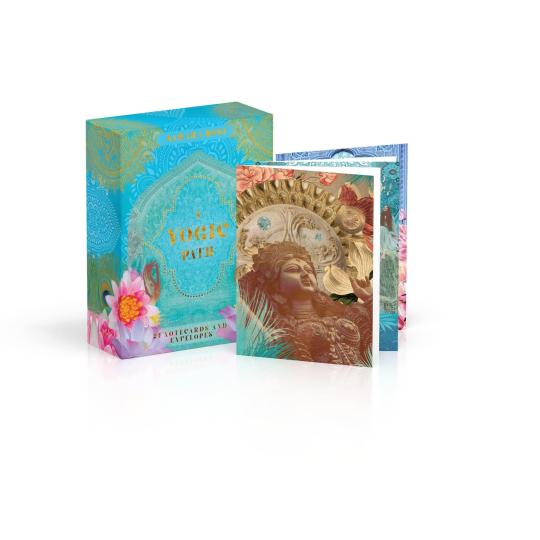
A Yogic Path Notecards: 24 Notecards and Envelopes A Yogic Path Notecards: 24 Notecards and Envelopes Cards – December 7, 2021 by Sahara Rose Ketabi (Author), Danielle Noel (Illustrator) ---Brand New--- Based on the best-selling oracle deck A Yogic Path, this notecard collection is the perfect gift for yoga enthusiasts, mystics, and anyone seeking spiritual inspiration. • Twelve inspirational designs: The front of each notecard features an image from A Yogic Path. The back of the card provides a description of the deity or concept represented as well as a message of empowerment. • Any occasion: Card interiors are blank for your message, whether it's a birthday greeting, a thank you note, or just a note to say hello. • Suitable for display: Frame notecards for display, pin them to a vision board, or incorporate them into an altar. About the Author Sahara Rose is the best-selling author of Eat Feel Fresh: A Contemporary Plant-Based Ayurvedic Cookbook and Idiot's Guides: Ayurveda and creator of A Yogic Path Oracle Deck and Guidebook. She is host of the Highest Self Podcast, a top-ranked podcast in the spirituality category on iTunes. She has been called "a leading voice for the millennial generation into the new paradigm shift" by Deepak Chopra, and she loves to make spiritual and Ayurvedic wisdom fun and relatable so it can serve the needs of today's people. Discover your Dosha with her free quiz at iamsahararose.com and connect with her for daily spiritual wisdom on Instagram and Facebook @iamsahararose. Danielle Noel is a visual artist and oracle designer who weaves ancient mysticism and energy medicine into new wellness tools. She is the creator of The Starchild Tarot, The Moonchild Tarot, and the author of The Book of Tarot: A Guide for Modern Mystics. She also illustrated A Yogic Path Oracle Deck and Guidebook. Find her on Instagram and Facebook @daniellenoel.art. Publisher : Alpha (December 7, 2021) Language : English Cards : 48 pages ISBN-10 : 0744044480 ISBN-13 : 9780744044485 Item Weight : 1.55 pounds Dimensions : 5.31 x 2.5 x 7.06 inches
0 notes
Text
Post 4: Understanding the Five Types of Mental Fluctuations: Patanjali’s Sutras 1.5 and 1.6
In our previous post, we reflected on the profound distinction between the Seer and the fluctuations of the mind, as described in Sutras 1.3 and 1.4. Patanjali taught us that when the mind is still, the Seer abides in its true nature. When the mind is not still, we identify with the fluctuations, creating a misperception of reality. This realization is crucial for the practice of yoga, as it…
#calming the mind#clarity of mind#distinguishing Seer from mind#five types of vrittis#imagination and mind#Inner stillness#memory and yoga#mental fluctuations in yoga#mental modifications#mental peace through yoga#mind-body balance#observing thoughts#Patanjali Sutra 1.5#Patanjali Sutra 1.6#path to liberation#Raja Yoga#right knowledge in yoga#Self-awareness#sleep as a mental fluctuation#Spiritual Practice#Swami Vivekananda translation#vrittis and suffering#wrong knowledge in yoga#Yoga Sutras of Patanjali#yogic insight#yogic philosophy#yogic wisdom
1 note
·
View note
Text
The Universal Gesture of the Raised Right Hand






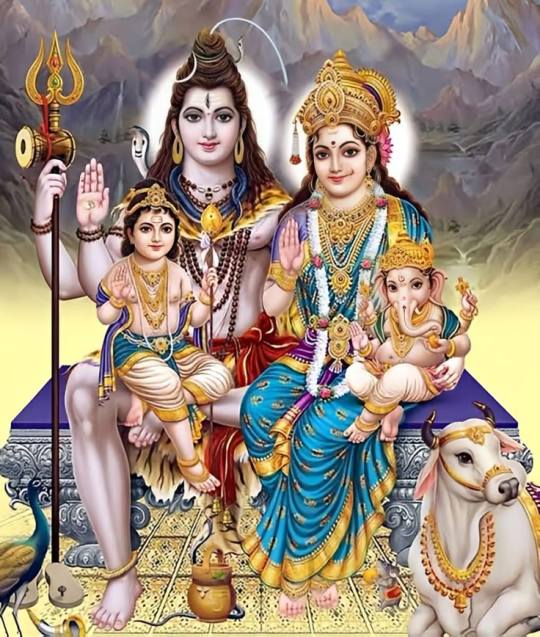
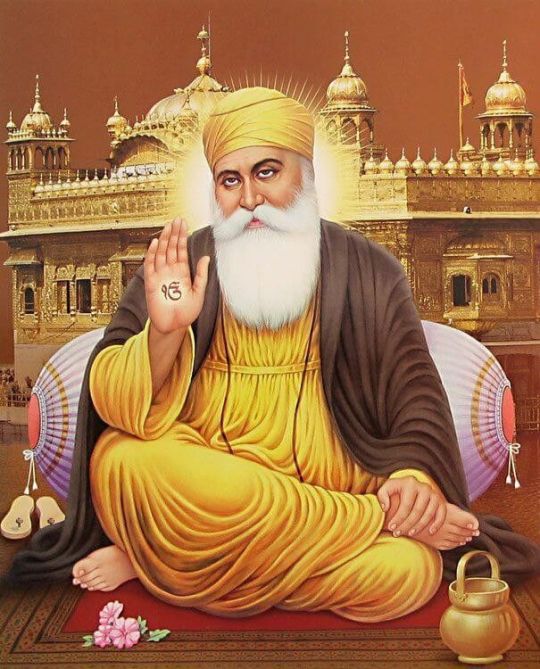


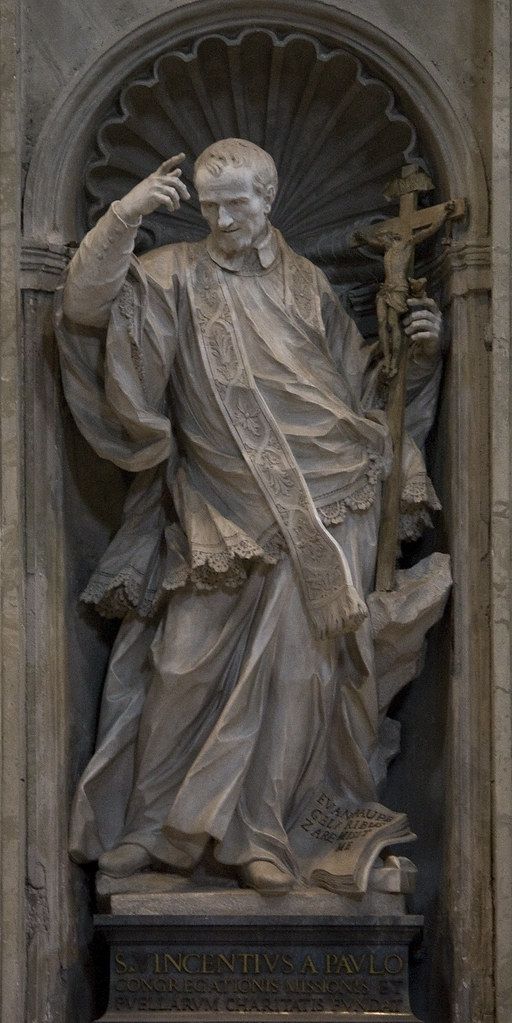

The raised right hand, a gesture seen across various religions, spiritual traditions, and artistic depictions, carries with it profound symbolic meaning. This ubiquitous gesture is often linked to themes of blessing, protection, authority, and enlightenment, and has been shown in the iconography of deities, spiritual leaders, and mystics for millennia. Its recurrence suggests it is more than just a physical movement; it embodies a universal archetype that is deeply ingrained in human consciousness. Through examining the gesture's origins, symbolism, and often suppressed meanings, we can gain profound insights into its role as a bridge between the material and the divine.
Core Symbolism Across Traditions
At its core, the raised right hand symbolizes reassurance and spiritual power. Across different traditions, it conveys a sense of divine protection, authority, and the dispelling of fear. In Hinduism and Buddhism, this gesture is epitomized in the Abhaya Mudra, which translates to “gesture of fearlessness.” The Buddha, often depicted with his right hand raised to shoulder height, palm outward, uses this gesture as a symbol of peace and protection, calming the fears of the devotee. Similarly, Hindu deities like Vishnu and Shiva adopt this mudra to bestow blessings and offer divine assurance.
Christian and Cross-Cultural Depictions
In Christianity, the gesture is closely associated with Jesus Christ, who is frequently depicted raising his right hand in a benediction, signifying the transmission of divine grace and spiritual power. Mary, too, is shown in similar contexts, her hand raised in a gesture of blessing. The raised right hand also carries significance in Sikhism, where Guru Nanak's gesture symbolizes divine truth and guidance. Even in occult traditions, figures such as Baphomet incorporate this gesture to represent the balance between the spiritual and material realms, echoing the principle of "as above, so below." The universality of this gesture underscores its association with spiritual authority across various cultures.
Esoteric Meaning and the Right-Hand Path
Beyond its religious and spiritual meanings, the raised right hand also has esoteric significance. It is often seen as a symbol of the "Right-Hand Path," a concept tied to righteousness, divine order, and enlightenment. This contrasts with the "Left-Hand Path," which is often associated with hidden knowledge or rebellion against established norms. This duality—light versus dark, order versus chaos—encapsulates humanity’s ongoing journey to balance material existence with spiritual transcendence.
Prehistoric and Ancient Origins
The origins of this sacred gesture stretch far back into prehistory. Before the advent of organized religion, prehistoric shamans—spiritual leaders adept at navigating altered states of consciousness—likely used the raised right hand as a nonverbal form of communication with higher realms. Cave paintings dating back over 30,000 years show figures with raised hands, suggesting a deep, intuitive connection between this posture and spiritual invocation. As civilizations emerged, this gesture became more formalized within religious and ceremonial contexts.
In ancient Sumer (around 4000 BCE), gods and rulers were often depicted with raised hands, invoking divine authority. Similarly, in ancient Egypt, deities like Osiris and Isis are frequently shown with their hands raised during sacred rituals. The Indus Valley Civilization (circa 2500 BCE) integrated mudras, symbolic hand gestures, into their early yogic practices. The Vedic texts (circa 1500 BCE) codified these hand gestures within Hindu rituals, associating them with the control of energy and blessings. Buddhism later adopted the Abhaya Mudra, as exemplified by the Buddha, who used it to calm a charging elephant sent by his cousin Devadatta, symbolizing serene power and protection.
An Archetype Across Cultures
Despite regional differences, the raised right hand has consistently symbolized divine connection across cultures. Its prevalence suggests an archetypal truth embedded in the collective human consciousness, one that spans time and geographical boundaries.
Esotericism and the Mystical Hand
In esoteric traditions such as Freemasonry and Hermeticism, the raised right hand goes beyond a simple gesture of blessing. It symbolizes the oath of initiation into higher knowledge, invoking cosmic truths that transcend ordinary understanding. The human hand itself is often viewed as a microcosm of divine creation, with its five fingers corresponding to the pentagram—a symbol of balance—and the five elements: earth, water, fire, air, and spirit. Ancient cultures believed that certain hand positions could channel energy flows within the body or invoke universal forces, further amplifying the significance of the raised right hand.
Duality and Balance in Symbolism
The duality inherent in this gesture reflects broader cosmic principles. The right hand is often associated with light, order, and divine authority, while the left hand is linked to chaos, hidden knowledge, or rebellion. This contrast is vividly illustrated in occult symbolism through figures like Baphomet, who is depicted with one hand pointing upward, toward the heavens, and the other pointing downward, toward the earth. Baphomet embodies the balance between opposites, serving as a reminder that spiritual enlightenment requires the reconciliation of dual forces.
Suppression of Esoteric Knowledge
Yet, beneath these surface meanings lies a deeper layer of significance, one that has often been suppressed or reinterpreted throughout history. Many cultures embraced the raised right hand as a sacred symbol, but its more esoteric meanings have often been obscured by religious institutions seeking to control spiritual knowledge. The myths surrounding pre-flood civilizations—such as Atlantis—speak of societies that possessed profound knowledge of sacred geometry, cosmic cycles, and spiritual science. This knowledge was likely lost or deliberately erased after catastrophic events reshaped human history.
Early Christianity, too, contained mystical teachings that were later suppressed by institutionalized religion. Gnostic texts describe Jesus as a teacher of self-mastery, rather than blind submission to external authority. Concepts such as reincarnation, which were central to early Christian thought, were removed from doctrine during Church councils. Similarly, the role of Mary Magdalene as an equal spiritual leader was diminished to reinforce patriarchal structures. These omissions serve to obscure Christianity's esoteric roots, favoring dogma over personal enlightenment.
Sound, Frequency, and Vibrational Truths
In addition to these religious suppressions, the science of sound and frequency also holds a key to understanding the deeper significance of the raised right hand. Ancient civilizations understood that sound shapes reality, a concept encoded in sacred languages like Sanskrit and Hebrew. The standard tuning of modern music (440 Hz) contrasts with ancient systems such as 432 Hz tuning, which is believed to harmonize with natural frequencies. This shift may represent a deliberate attempt to disrupt humanity's connection to higher vibrations, further distancing the masses from their spiritual potential.
The Moon and Frequency Control Theories
Some esoteric traditions even suggest that the Moon, with its perfect size for eclipses, may have been artificially placed in Earth's orbit as part of a control mechanism for human consciousness. Its presence raises questions about its origins and whether it serves as a frequency regulator, locking humanity into specific vibrational states.
Ultimately, the raised right hand represents more than just a symbolic gesture; it embodies humanity's shared spiritual heritage. Its presence across cultures suggests that it encodes universal truths about enlightenment: mastery over physical reality through alignment with cosmic laws, protection from ignorance, and guidance toward higher planes of existence. Yet, much of its deeper meaning remains hidden beneath layers of historical suppression and reinterpretation. By rediscovering these lost meanings—whether through ancient texts or modern esotericism—we can begin unlocking humanity's full potential for spiritual awakening.
The raised right hand, as a timeless and powerful gesture, continues to beckon us toward greater understanding and unity with the divine. It is a symbol that transcends time and culture, offering us an ancient key to uncovering the profound mysteries of the universe. Through it, we are reminded of our intrinsic connection to higher wisdom and the eternal quest for spiritual enlightenment.
#symbolism#iconography#sacred iconography#sacred symbols#mystical#mysticism#divine authority#mythical christianity#esoteric christianity#esoteric#occultism#occult#occult symbols#tradition#mudras#buddhism#buddhist#vedic wisdom#vedic#spiritual#spiritual protection#sacred geometry#hermetic#transcendentalism#gnosticism#gnostic teachings#gnosis#religious art#art history#mind over matter
106 notes
·
View notes
Text
𝐞𝐯𝐞𝐫𝐲𝐭𝐡𝐢𝐧𝐠 𝐲𝐨𝐮 𝐧𝐞𝐞𝐝 𝐭𝐨 𝐤𝐧𝐨𝐰 𝐚𝐛𝐨𝐮𝐭 𝐜𝐡𝐚𝐤𝐫𝐚𝐬



what even are chakras?
chakras (from the sanskrit word cakra, meaning “wheel” or “disc”) are spinning vortexes of subtle energy that exist within your pranic body (also called the “subtle body”). they’re not physical organs, but energetic hubs where mind, body, and spirit meet.
chakras were described as energy centers (padmas, or “lotuses”) that store prana: life force, within the subtle body, which is different from the physical body.
this subtle body is composed of nadis (energy channels), koshas (layers of consciousness), and chakras (energy hubs).
the original chakra texts were written in sanskrit, and the most detailed source comes from the shat-chakra-nirupana, a 16th-century tantric text that laid out the seven main chakras and their symbolic, spiritual, and physiological associations.
they influence your thoughts, emotions, physical health, spiritual growth, relationships, and even your damn bank account.
when your chakras are healthy and flowing freely, your whole life aligns like sacred geometry. when they’re blocked or chaotic? expect spiritual lag, emotional glitches, physical illness, and endless chaos.
important to note:
in the original tantric system, chakras weren’t “self-care tools” they were maps to divine awakening used during intense yogic, meditative, and kundalini practices to transcend ego, illusion, and reincarnation. it was liberation tech, not lifestyle inspo.
but now, in this modern age of energy work, psychology, and soul evolution, the chakra system has become a universal template applicable to everyone, not just yogis. and we’re gonna fuse that original wisdom with real psychology, real healing, and real magic.
origin of the chakra system
• earliest references to energy centers show up in the Vedas (ancient hindu scriptures) around 1500–1000 BCE.
• the shat-chakra-nirupana, a 16th-century tantric text, outlined the 7-chakra system most people know today.
• the system was never meant to be aesthetic it was part of a serious spiritual practice to activate kundalini shakti, the dormant divine feminine energy said to be coiled at the base of your spine.
originally, chakra work was about liberating the soul from illusion (maya) and achieving moksha (spiritual liberation). but in today’s world, chakra healing can help you:
• release trauma + emotional baggage
• align with your highest self
• create energetic flow in your career, love life, and creative path
• experience divine connection + psychic expansion
how do chakras work?
imagine 7 power stations wired along your spine. each one governs a certain aspect of your physical body, emotional world, mental patterns, and spiritual connection.
when they’re:
• balanced → energy flows freely = peace, joy, purpose, radiance
• blocked → stuck energy = fear, fatigue, illness, toxic patterns
• overactive → too much energy = burnout, anxiety, ego overdrive
• underactive → not enough energy = apathy, insecurity, numbness
your 7 main chakras
1. root chakra – muladhara
“i exist. i survive. i am grounded.”
• sanskrit: mula = root, adhara = support/foundation
• location: base of spine, pelvic floor
• element: earth
• color: red
• mantra: LAM
• gland: adrenal glands (fight-or-flight center)
• body link: spine, legs, bones, colon
• psych themes: survival, money, stability, belonging, family, safety
imbalanced symptoms:
• underactive: anxiety, disconnection, poverty mindset, fear of abandonment
• overactive: hoarding, controlling behavior, stubbornness, material obsession
• trauma imprints: childhood neglect, abandonment, physical abuse etc.
when balanced:
• you feel safe in your body and the world
• you can build structure and discipline with ease
• you attract abundance + grounded stability
• you trust life even when it’s hard
healing tools:
• grounding meditations
• red foods: beets, root vegetables, chili
• physical touch, body-based therapies (somatic work)
• walk barefoot, work with hematite, black tourmaline
• build routines + financial structure
• affirmation: “i am worthy of safety and abundance.”
2. sacral chakra – svadhisthana
“i feel. i create. i allow pleasure.”
• sanskrit: sva = self, adhisthana = dwelling place
• location: lower abdomen, 2 inches below navel
• element: water
• color: orange
• mantra: VAM
• gland: reproductive system
• body link: womb, bladder, hips, genitals
• psych themes: sensuality, emotions, creativity, pleasure, intimacy
imbalanced symptoms:
• underactive: numbness, shame, low libido, creative block, disconnection from body
• overactive: hypersexuality, addiction, obsession, drama
• trauma imprints: sexual abuse, body shame, religious guilt, heartbreak
when balanced:
• you radiate magnetism, sensuality, and artistic flow
• your emotions move freely without controlling you
• you’re tapped into your divine feminine and creative life force
• you allow yourself to feel pleasure without guilt
healing tools:
• sensual dance (belly dance, twerking, slow flow yoga)
• sacred baths with rose + orange oil
• creative practices (painting, singing, scripting)
• orange calcite, moonstone
• inner child + womb healing
• affirmation: “i honor my body. i deserve to feel good.”
3. solar plexus – manipura
“i act. i choose. i claim my power.”
• sanskrit: mani = jewel, pura = city → “city of jewels”
• location: stomach, between ribs and navel
• element: fire
• color: yellow
• mantra: RAM
• gland: pancreas + digestive system
• body link: liver, gallbladder, intestines
• psych themes: identity, ambition, boundaries, ego, self-discipline
imbalanced symptoms:
• underactive: low self-esteem, indecision, victim mentality
• overactive: arrogance, perfectionism, aggression, burnout
• trauma imprints: bullying, strict parenting, humiliation, failure shame
when balanced:
• you’re decisive, empowered, and assertive without arrogance
• you have strong boundaries and healthy self-esteem
• you feel motivated and energized to go after what you want
• you become a natural leader
healing tools:
• sunbathing, breath of fire, core exercises
• wear yellow, work with citrine or pyrite
• personal power rituals (write + burn limiting beliefs)
• practice saying “no”
• affirmation: “i am the author of my life. i am enough.”
4. heart chakra – anahata
“i love. i forgive. i connect.”
• sanskrit: anahata = unstruck, infinite sound
• location: center of chest
• element: air
• color: green / pink
• mantra: YAM
• gland: thymus (immune system)
• body link: lungs, heart, arms, hands
• psych themes: compassion, forgiveness, empathy, romantic love, grief
imbalanced symptoms:
• underactive: isolation, coldness, fear of intimacy, bitterness
• overactive: martyrdom, people-pleasing, jealousy, attachment
• trauma imprints: loss, betrayal, rejection, emotional neglect
when balanced:
• you feel deep connection to others and to life itself
• you radiate unconditional love without losing yourself
• your immune system strengthens (yes, real science backs this)
• you can forgive, grieve, and love again
healing tools:
• breathwork (especially heart coherence)
• ho’oponopono (forgiveness prayer)
• emerald, rose quartz
• write love letters to self
• self-compassion meditations
• affirmation: “i am love. i radiate unconditional compassion.”
5. throat chakra – vishuddha
“i speak. i express. i tell the truth.”
• sanskrit: vishuddha = purification
• location: throat and neck
• element: ether (space)
• color: sky blue
• mantra: HAM
• gland: thyroid
• body link: vocal cords, mouth, jaw, ears
• psych themes: communication, truth, expression, listening
imbalanced symptoms:
• underactive: fear of speaking, introversion, repression
• overactive: gossip, interrupting, dominating convos
• trauma imprints: being silenced, punished for truth, gaslighting
when balanced:
• you speak with clarity, confidence, and integrity
• your voice becomes a tool for healing and influence
• you can express yourself artistically and emotionally
• you’re deeply heard by others
healing tools:
• chanting, singing, vocal toning
• write + speak affirmations out loud
• journal your truth
• use lapis lazuli, blue lace agate
• affirmation: “my voice matters. i speak my truth with grace.”
6. third eye – ajna
“i see. i know. i trust my inner wisdom.”
• sanskrit: ajna = to perceive, to command
• location: forehead, between eyebrows
• element: light
• color: indigo
• mantra: OM
• gland: pineal gland (melatonin, circadian rhythms)
• body link: brain, eyes, sinuses
• psych themes: intuition, imagination, perception, clarity
imbalanced symptoms:
• underactive: confusion, over-intellectualizing, lack of faith
• overactive: paranoia, delusion, dissociation
• trauma imprints: disillusionment, spiritual rejection, fear of intuition
when balanced:
• you trust your intuition without needing external validation
• you see life symbolically, not just literally
• dreams become vivid and prophetic
• you develop inner wisdom + spiritual intelligence
healing tools:
• meditation (especially vipassana + visualization)
• dream journaling
• limit screen time
• work with amethyst or labradorite
• third eye massage
• affirmation: “i see clearly. i trust my soul’s vision.”
7. crown chakra – sahasrara
“i transcend. i merge. i remember who i truly am.”
• sanskrit: sahasrara = thousand-petaled
• location: top of the head
• element: pure consciousness
• color: violet / white
• mantra: OM
• gland: pineal + pituitary
• body link: brain, nervous system
• psych themes: spirituality, divine connection, oneness, transcendence
imbalanced symptoms:
• underactive: atheism, existential dread, lack of purpose
• overactive: spiritual bypassing, superiority complex
• trauma imprints: spiritual rejection, religious abuse, nihilism
when balanced:
• you experience oneness with the universe
• you tap into divine downloads, flow states, soul alignment
• you feel limitless, guided, and expansive
• you recognise yourself as a vessel for higher love + wisdom
healing tools:
• meditation in silence
• crown chakra mudras + breathwork
• read sacred texts / study universal wisdom
• selenite, clear quartz
• fast or detox occasionally
• affirmation: “i am one with the divine. i am infinite consciousness in form.”
how to activate, align, and master your chakras daily
• do chakra meditation
• listen to solfeggio frequencies for specific chakras
• wear color-coded outfits / makeup to amplify each chakra
• eat chakra-aligned foods for lunch + dinner
• pull tarot spreads for each chakra to check your energy
• speak chakra mantras out loud in order to harmonize your field
• visualize golden energy spiraling from root to crown every night
#girlblogging#dream life#empowerment#levelling up#manifestation#manifesting#love#aesthetic#gaslight gatekeep girlboss#chakras#meditation#spirituality#spiritual awakening#girlboss fr#just girlboss things#becoming that girl#that girl#queen#it girl#positivity#positive thoughts#dream lifestyle#manifest your dreams#female manipulator#devine feminine#im just a girl#level up#witchblr#witch community#witchcraft
105 notes
·
View notes
Text
Weighing in on ATLA shipping discourse

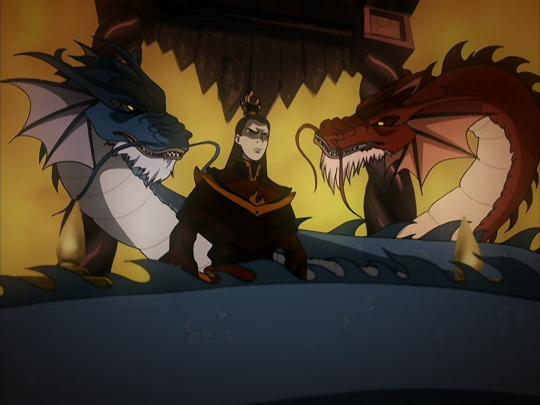
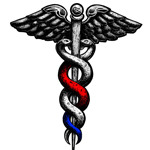
Iroh: You're not the man you used to be, Zuko. You are stronger and wiser and freer than you have ever been. And now you have come to the crossroads of your destiny. It's time for you to choose. It's time for you to choose good.
Why did Zuko have a fever after decided to let go of his Blue Spirit mask? Well, the imagery suggested that he experienced a Kundalini awakening. A Kundalini awakening is a profound spiritual experience that involves the activation and rising of Kundalini energy, located at the base of the spine. In Hindu and yogic traditions, Kundalini is often depicted as a coiled serpent, symbolizing dormant spiritual potential.
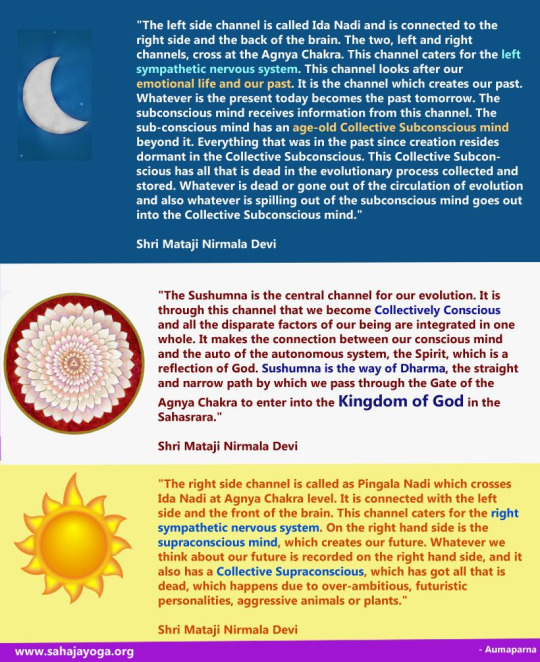
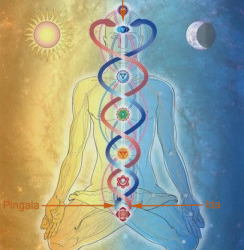
Ida and Pingala are the two energy channels that run alongside the spinal column and correspond to the left and right sides of the body, respectively. Ida is associated with the feminine or yin aspect. It is linked to qualities such as calmness, receptivity, intuition, and nurturing. It is also associated with the moon, coolness, and the element of water.
Pingala represents the masculine or yang aspect. It is associated with qualities such as activity, dynamism, alertness, and willpower. It is associated with the sun, warmth, and the element of fire. In the yogic tradition, the balance and harmonization of Ida and Pingala are considered essential for achieving physical, mental, and spiritual well-being.
Once the two energies combine at the crown chakra, a person's consciousness is supposed to transcend duality. What does that mean, exactly? It means to move beyond the perception of reality as consisting of opposing or dualistic concepts, such as good and bad, light and dark, right and wrong, or self and other. You understand that these apparent opposites are part of the same unified whole and are interconnected in a deeper, more profound way.
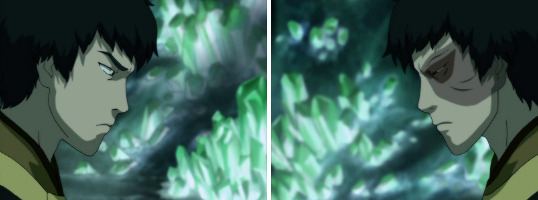
"I was head writer of ATLA, and this is exactly how I see it! There was some controversy that Zuko made the "wrong choice" at the end of season 2. A lot of fans were ANGRY! But it had to be this way… we wanted him to get everything he thought he wanted. The triumphant return. His father's respect, and a seat at his right hand. Only then could Zuko truly outgrow these things, and choose to do the right thing in a meaningful way." (Aaron Ehasz)
So, the symbolism definitely favors Zutara in that respect. Katara learned through Zuko that the Fire Nation is not innately evil. Even though he hurt her with his "wrong" decision, part of her character arc was understanding why he did it and being able to forgive him. And because he made that choice, she could trauma-dump onto him and that led to her gaining closure about her mother's death.
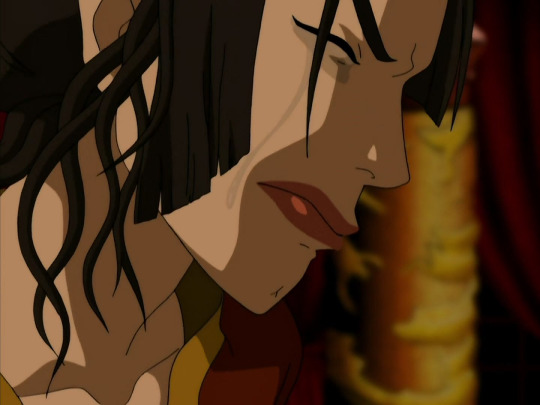
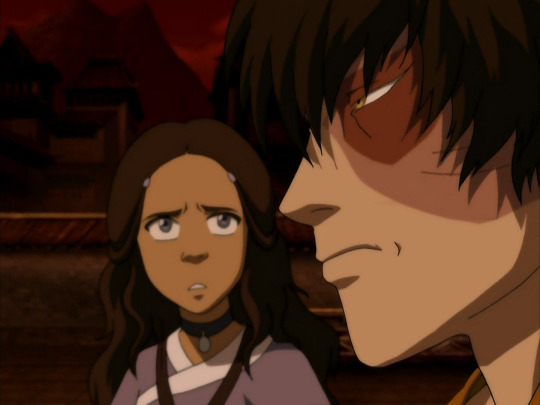
"I was head writer of ATLA. Azula and Zuko's relationship was not always well understood, even by the team internally. Azula loved Zuko, more than anyone save her father. She also felt competitive with him for their parents' attention of course, but since she had alienated herself from her mother, she focused her energy on pleasing dad… which of course meant acting in more and more intense and possibly evil ways." "By the end of the series, of course, her loss of her friends shatters the part of her identity that she could somehow control affection and love through intimidation. As a result she spirals… I did however intend to leave a kernel of humanity, and had we made a season 4 Azula would have completely bottomed and we would have explored the possibility of a path to redemption. True story!" (Aaron Ehasz)
But it's not even just Zutara. What I found interesting was that Azula was the blue dragon and Iroh the red dragon. Azula was crazy and needed to go down, right? By siding with his sister, you're meant to think that Zuko chose "evil" instead of "good". But it looks like some of the writers meant for it to be more complicated than that. There was no "good" or "evil" choice. Azula had a softer "yin" side, too.
Zuko wanted to get along with his sister. He did not want to kill her, even though Iroh thought that was the only option. The fact that Azula never got her redemption arc did a massive disservice to Zuko's arc as well. The fact that Azula had good in her is exactly why Zuko's choice in BSS couldn't truly be called "wrong" or "evil".
Azula loved Zuko and that idea wasn't conveyed very well in the cartoon. She was the one person on that beach who actually did understand him. She was jealous that Zuko chose the Avatar over her. And she knew that targeting Katara with her lightning was the best way to hurt Zuko. Katara found a non-lethal way to defeat Azula for Zuko's sake. Because after seeing how hard it was for him to fight her, she finally understood why he made his choice in Ba Sing Se.
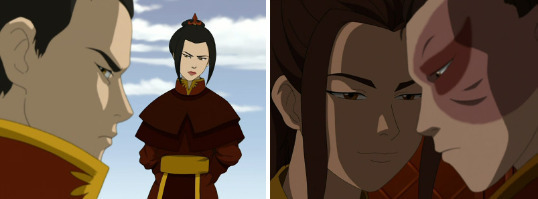
"[Azula] had not bottomed in the end of season 3, she had further to go. At the deepest moment in her own abyss she would have found: Zuko. Despite it all, her brother Zuko would be there for her. Believing in her, sticking by her, doing his best to understand and help her hold her pain that she can no longer hold alone. Zuko — patient, forgiving, and unconditionally loving – all strengths he gained from Uncle Iroh." "And I always imagined that after coming out the other side, she would be one of those people who hilariously over-shares her own feelings all the time, and that she would be a bit over-apologetic. Like a Canadian version of Azula." (Aaron Ehasz)
The first episode of Book 3 was called The Awakening. Aang literally awakened to the energy twisted up in the middle of his back. He did not complete his spiritual transformation. The Kundalini energy did not reach his crown chakra. It was still blocked because he had an attachment to Katara that he hadn't worked through yet.
Zuko's awakening was figurative. Mai didn't understand how he felt. Symbolically, when she turned his head to kiss him, it showed the audience the scarred side of his face. When Zuko lied his sister, the unscarred side of his face was shown. I suspect that the writer for the episode, Aaron Ehasz, wanted to hint that Zuko did still feel a connection to Katara and didn't want Azula going after her and Aang.
Zuko in The Crossroads of Destiny was not supposed to be the same Zuko from The Avatar State. Both versions of Zuko still wanted to go home. But 201 Zuko was motivated more by selfish attachment. 220 Zuko was more motivated by love. He loved Azula unconditionally. Even with all of her twisted, ugly, and cruel behavior. His consciousness had transcended the duality of Iroh and Azula being opposites where one is "bad" and the other is "good". During The Beach he was fantasizing about a time when Iroh played with both of them as little kids. Back when they were all a family.
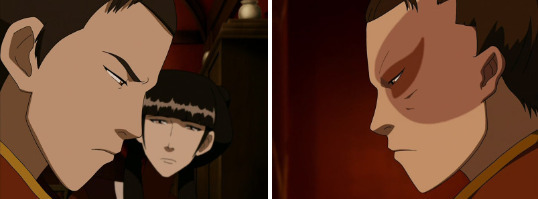
Mai: You know what will make you feel better? Ordering some servants around. I might be hungry for a whole tray of fruit tarts. And maybe a little palanquin ride around town. Double time.
I don't dislike Mai. I think she is an interesting character who was not a bad person or anything. I just thought she served a very specific narrative purpose. She was there to show how Zuko wasn't compatible with his old lifestyle anymore.
Mai wanted a typical socialite boyfriend. They really didn't get along too well or have much to say to each other during The Beach. She didn't like him when he started talking about his trauma and showed his uglier side. Zuko was insecure and jealous because he was not even sure if she really liked him. And she didn't even know the person he was after his banishment, only the person he was as a child. When he turned his head away from her, his unscarred side was shown.
Zuko: When I got to the meeting, everyone welcomed me. My father had saved me a seat. He wanted me next to him. I was literally at his right hand. Mai: Zuko, that's wonderful! You must be happy. Zuko: During the meeting, I was the perfect prince. The son my father wanted. But I wasn't me.
He walked out of that war meeting with the scarred side showing. Mai didn't love Zuko. She loved the perfect prince. The fantasy she built up in her head and the role Zuko was acting out at the start of the episode when he was ordering her the fancy fruit tarts.
Mai: I guess you just don't know people as well as you think you do. You miscalculated. I love Zuko more than I fear you.
Mai stood up to Azula to save Zuko, and she genuinely believed she loved him. But he left her behind to be with his new companions. If not for Ty Lee, she would have died. That should have been the end of that relationship. I thought it was very weird that they got back together. The NATLA writers should definitely find a different way to conclude Mai and Ty Lee's character arcs. Especially Mai. She deserved a more dignified ending than being left in prison and then threatening her ex-boyfriend to take her back.

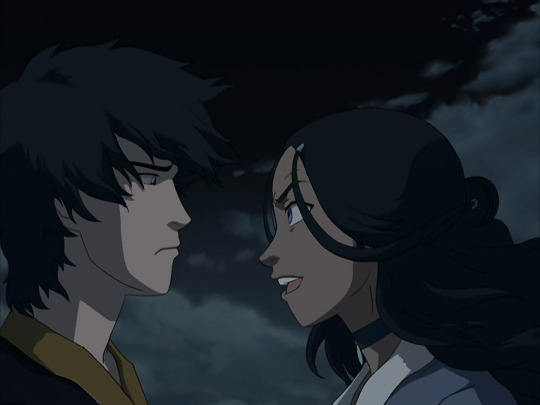
"I love that even though Aang is sort of not in this story very much, to me, he's-his presence is in all of these scenes 'cause you know he's like the little angel on her shoulder [...]" (Bryan Konietzko)
The main reason I think the shipping discourse in the ATLA fandom is so toxic is because the creators Mike and Bryan saw the narrative differently than the other writers. They seemed to have a completely different vision for the story and characters compared to the head writer. So, there were two conflicting visions and fans who liked one over the other could argue their side indefinitely. Bryke saw things as more black-and-white and good vs. evil. You can see it in some of the interviews and commentary, particularly with Bryan.
IMO, there really was no "good" and "evil" side in The Southern Raiders. There was no "angel" or "devil" sitting on Katara's shoulders. To Katatra, what Aang said must have sounded like nothing more than a trite platitude. It's true that in the end, she didn't choose violence. But I don't think Aang's words were very pertinent to her decision-making when she finally faced Yon Rha, LOL.
It's understandable why Aang would come off as preachy, though. He was just a child coping with his own grief. The Air Nomads' philosophy was one of the only things he had left of them, after all. Such a teaching was no doubt his own personal coping mechanism.
Aang was right in the sense that Katara didn't need to resort to violence in the end. But ya know, maybe she would have if she didn't have someone by her side who understood her inner darkness and accepted her even if she had chosen violence. Just like how Aang might have killed the sanbenders if Katara hadn't been there. And Katara would not have condemned him if he had done so.
"Zuko and Katara might have shared some sparks, but sometimes there are people along your 'journey of love' who are there to teach you about yourself and what you really need, but don't necessarily end up being your partner. Come on, kids! 'Zutara' never would have lasted! It was just dark and intriguing." (Bryan Konietzko)
Zuko was a character of duality. Yin and Yang. Light and shadow. His two sides were represented by the scarred side and non-scarred sides of his face. I think Bryan viewed Zutara as a "dark" ship because a big part of Zutara was about Katara's shadow side.
Just like Mai did with Zuko, Aang built up a fantasy version of Katara in his head. The perfect, well, "waifu," I guess. The endlessly patient feminine maternal figure. The sweet beautiful girl with such manageable hair. But that's only half of who she was. There was another side to her that he never saw. One that used bloodbending. Angry, hateful. Yes, even ugly. And that's not a bad thing. It's human.
213 notes
·
View notes
Text


"Shiva is the silence between thoughts, the space between breaths, the stillness within the storm." - Guru Nanak.
"When you peel away the layers of ego and illusion, what remains is Shiva – the pure, unadulterated consciousness." - Rumi.
Mount Kailash – The Abode of Shiva Talon Abraxas Hindus believe Mt.Kailash to be the abode of Lord Shiva. Like many of the Hindu gods, Shiva is a character of apparent contradictions. He at once the Lord of Yoga and therefore the ultimate renunciate ascetic, yet he is also the divine master of Tantra, the esoteric science that regards sexual union as the most perfect path to spiritual enlightenment. According to legend, immortal Shiva lives atop Kailash where he spends his time practicing yogic austerities, making joyous love with his divine consort, Parvati, and smoking ganja, the sacred herb known in the west as marijuana, Hindus do not interpret Shiva's behaviors as contradictory however, but rather see in him a deity who has wisely integrated the extremes of human nature and thus transcended attachment to any particular, and limited, way of being. For a Hindu, to make the arduous pilgrimage to Kailash and have the darshan (divine view) of Shiva's abode is to attain release from the clutches of ignorance and delusion.
34 notes
·
View notes
Text

All the promises we have heard are pure seduction. We expect the teachings to solve all our problems; we expect to be provided with magical means to deal with our depressions, our aggressions, our sexual hangups.
But to our surprise we begin to realize that this is not going to happen. It is very disappointing to realize that we must work on ourselves and our suffering rather than depend upon a savior or the magical power of yogic techniques. It is disappointing to realize that we have to give up our expectations rather than build on the basis of our preconceptions.
We must allow ourselves to be disappointed, which means the surrendering of me-ness, my achievement.
We would like to watch ourselves attain enlightenment, watch our disciples celebrating, worshiping, throwing flowers at us, with miracles and earthquakes occurring and gods and angels singing and so forth.
This never happens. The attainment of enlightenment from ego's point of view is extreme death, the death of self, the death of me and mine, the death of the watcher. It is the ultimate and final disappointment.
Treading the spiritual path is painful. It is a constant unmasking, peeling off of layer after layer of masks. It involves insult after insult.
~ Chogyam Trungpa Rinpoche
*** "The Myth of Freedom"
17 notes
·
View notes
Text
कुंडलिनी योग हे शास्त्र आत्मज्ञान प्राप्तीचा राजमार्ग
ते कुंडलिनी जगदंबा । जे चैतन्यचक्रवर्तींची शोभा ।जिया विश्वबीजाचिया कोंभा । साउली केली ।। २७२ ।। ज्ञानेश्वरी अध्याय सहावा ओवीचा अर्थ – जी कुंडलिनी जगाची आई आहे, ब्रह्मरूपी सार्वभौमाची शोभा आहे व जिनें विश्वाच्या बीजाच्या कोंभाला सांवली केली आहे. आश्रय दिला आहे. ही ओवी कुंडलिनी शक्तीचे गौरवगान करणारी आहे. ज्ञानेश्वर महाराज कुंडलिनी शक्तीचे वर्णन करताना ती जगदंबा आहे असे म्हणतात, म्हणजेच साऱ्या…
#breath control#chakra awakening#consciousness#energy centers#enlightenment#ida pingala#Indian spirituality#Inner Energy#inner light#kundalini awakening#kundalini shakti#kundalini yoga#meditation#Pranayama#self-realization#spiritual awakening#Spiritual path#spiritual science#subtle body#sushumna nadi#yoga philosophy#yoga practice#yoga tradition#yogic path#अंतःप्रकाश#अंतःशक्ती#आत्मजागृती#आत्मज्ञान#आत्मप्रकाश#आध्यात्मिक मार्ग
0 notes
Text

Good time to everyone who might find this reading for the collective.
today's reading is giving me big relationship appreciation vibes, which does build off of the last reading i did. i'm getting this idea that some folks out there need to appreciate their existing relationships for what they are.
the nine of cups conveys this idea of having your emotional and social needs met, of having lived a life that reaps rewards and adheres to one's values and results in contentment and fulfillment. this contrasts a bit with the reversed five of pentacles which tells me that you aren't actually wanting for anything yet you perhaps struggle to feel that is true. maybe financial concern is weighing on you and has been your priority for so long that even though you've taken control of the situation and are comfortable, you still feel sort of triggered into that hoarding mindset. this matches with the left oracle card, valerian (acceptance), which speaks to calming the unsafe inner child and focusing on what you do have and calmly accepting progress and change as having happened already.
the king of cups and the reversed ten of cups. phew, you already have so much in front of you but you've idealized this perfected image of happiness to the point that this vision is poisoning your domain. you already rule your emotional landscape but you want more, you want perfection. let that go. you have far more emotional strength and social prowess than you realize and even if you are sometimes awkward or you fight with your family, you are still surrounded by love and fulfillment. this matches with the way lalita tripura sundari reminds us to pursue that which brings us pleasure, that which is sensual and of the body. indulge in your friendships, familyships, and romances. savor every bite of your next meal (and don't be afraid to sop up the decadent sauce at the end). life is made to be lived, to be enjoyed. indulge in being alive.
allow yourself to derive deep joy from your loved ones. allow yourself to love yourself. you do not have to love perfectly, you only have to love.
after all. as within, so without.
#witchcraft#witch#witchblr#tarot#tarot cards#tarotblr#divination#daily tarot#daily divination#daily draw#roaen reads#bianco nero tarot#bianco nero#a yogic path#yogic path oracle#herbal astrology oracle#oracle cards#oracle#collective reading
4 notes
·
View notes
Text
Spirits and their common uses and misconceptions
So today I wanted to talk about a few spirits which, not much is so far known of through literary writing, but more so through celestial knowledge. (each spirit will have its own section)
The Pythoness - many Christian and Judea religions view the pythoness spirit as a demon like spirit that is meant to steer one away from Gods path and imbue one with negative thoughts such as death and sickness through the mind, yet I've personally found and many civilizations prior and after that the story is not as such. In yogic practices there is a certain breathe and practice of the kundalini. Kundalini is the term for "a spiritual energy or life force located at the base of the spine", conceptualized as a coiled-up serpent. The practice of Kundalini yoga is supposed to arouse the sleeping Kundalini Shakti from its coiled base through the 6 chakras, and penetrate the 7th chakra, or crown. This allows for an open pathway as a connection to God, elevated spirits and the spirits of the afterlife, our ancestral spirits, within celestial planes. In buddhism giant serpents were seen as protectors of the dharma, the truth that liberates us, standing strong against any attack. Many psychics, seers, mediums, witches and tarot card readers tend to have a spirit who knows one of two things about divination, prophecy and esoteric knowledge, but the pythoness spirit is looked at more like the all seeing eye or the eye of ra and horus. In greek mythology Leto the great she-wolf was cursed to never give birth upon the land as Hera set her out to be cursed by her daughter and for Gaia to not allow her to give birth to her two children. Through Zeus' interference Leto was able to give birth to both Artemis and Apollo. Later Apollo went to go slay a Snake that had threatened Leto and therefore gained the ability to turn into a snake himself. He declared the island previously known as Pythos to be Delphi and as the God of prophecy later became a hub for those seeking answers from great oracles once a year, known as Pythias. These women were great prophets and witches alike that danced with fire and tamed snakes to dance along with them protecting the island from attacks and monsterous threats as to pay respect to Apollo. These were women and men of wild nature who allows there instincts to guide them through the understanding of the great divine. One with nature they became medicine workers, prophets, seers, musicians, dancers, pyromancers, snake charmers, witches and mages and dream weavers.
These great spirits are revered as a highly elevated court in spiritualist practices, sometimes just perceived as the spirits of tarot decks or oracular objects they are forgotten as being far too complex to be seen as just that. Through the force of light they bring great aid to those they are on spiritual journey's with, they rid of hexes, curses and spiritual illnesses. They guide through prophetic dreams, clairvoyancy, clairsentience, clairaudience and mediumship. They are capable of conjuring powerful spirits and the spirits of the dead (necromancy), as well as a straight line communication to God, gods and goddesses. They move through the celestial tides of the universe and bring forth great health, wealth, abundance, freedom and spiritual knowledge to those they favor. They are quite benevolent spirits who help bring in death or the spirit of change for the better and to rid old stubborn ways of the past. They are great teachers of dark and light magic. They aid in learning and music as well. Helping those with charisma and the ability to enchant and/or charm enemies and others alike. They have such affinity towards chocolates, gold, silver, wine, fire, candles, light, mirrors, divination tools, water, flowers and floral scents, perfumes, snakes and music. There number is 7 and their flower is the rose, particularly the white rose, but other colors are fine as well. They also enjoy sunflowers, as they venerated Apollo, and the Anise star. Their colors are Red, burgundy, gold, emerald green, white, silver, purple, and brown. Yet each is different and might prefer a royal blue for all we know each spirit is different to another so getting to know ones spiritual court is quite important. Stones like diamond, ruby, jade, emerald, citrine, labradorite and amethyst can be given to such spirit as well as Selenite and Amber each representing Artemis and Apollo. These spirits can sometimes be confused with a better known spirit Santa Martha la Dominadora. You may even have both within your spiritual court, but they two hold many similarities.
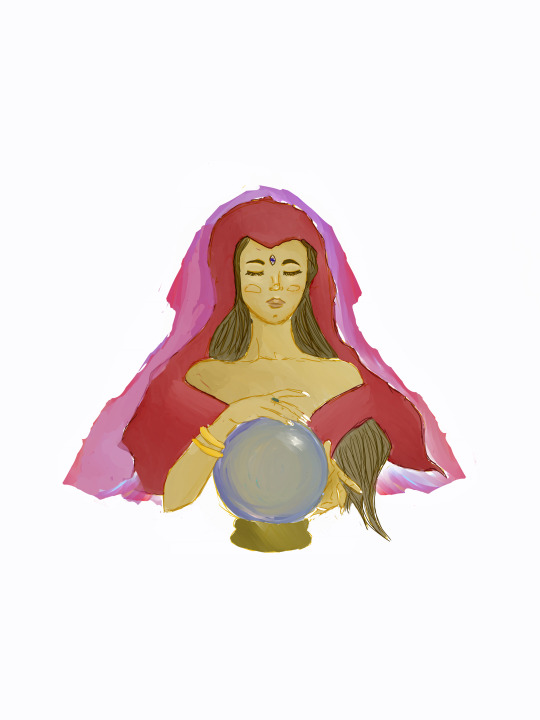

Prayer to the Pythoness
O Blessed Pythoness, I invoke your humble yet wild nature into my life, I give you thanks for the visions told and untold and for the sight to see my path clearly. May your connection to God and all living things be great and full of love and respect. May your tides of wisdom bring peace to the land and bestow upon me and my loved ones a blessed hand. Lady of the fire, imbue me with your holy flames may they burn away all evil done unto me by others or by my own hand. May your light charm those who seek no good into doing acts of kindness and greatness and may your soothing voice bring sweetness and riches to the land and seas. You the one who tamed the dragon and serpent to your gracious hand. Tame my enemies and bring good fortune to those in need. Help the world against devastation and may your great cobra bring forth the promise land. Lady of the land and sea, conjure your celestial winds to protect me and bring good news from the heavenly lands. Through the eye of the one who can see I plea to you humbly and in need. As it is. So mote it be. Amen
Say this prayer with Psalm 91 3x and Psalm 4 3x under the flame of a white(or yellow) light end with a Glory be. It will help receive divine messages through divination or prophetic dreams and help transmute negative energy and protect against evil eye.
Oracion a La Pitonisa
O Bendita Pitonisa, Yo invoco tu humilde y salvaje espiritu de naturaleza entre mi vida, te doy las gracias por los visiones contado y no contado y por la vista para ver mi camino claramente. Que tu conexión a Dios y a todas criaturas vivas sea lleno de gran amor y respeto. Que las olas de sabiduria traen paz a toda la tierra y otogar a mi y mis seres queridos tu mano bendicida. Mujer de los fuegos, envuelvame con tus llamas benditas que me liberan de cualquier maldad sea enviado por enemigos o que han nacido de mi propia mano. Que tu luz encandile a los que no buscan el bien y les transformas hacer actos de carino y grandeza y que tu voz encantadora trae dulcisimiento y riquezas a la tierra y los mares. Tu que haz vencido el serpiente y el dragon con tu mano graciosa. Ayuda al mundo contra la devastación y que tu tierra prometida sea traido por tu gran cobra. Mujer de la tierra y mar, protejame con los vientos celestiales y que traen buena noticias del cielo. A través del ojo del que puede ver te suplico humildemente y de necesidad. Como es. Asi sera. AMEN
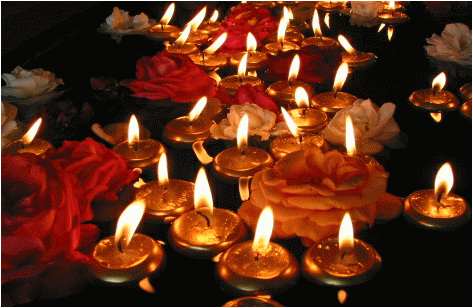
#espiritismo#spiritualism#spirituality#magic#white magic#spirits#pythia#pythoness#pitonisa#witchcraft#prayers#spiritualcourt#sanse#spells#brujo#bruja#brujeria#pagan#animism#ritual#occult#occultism#magick#esoteric#god#elevatedspirits#los espiritus#espiritus elevados
66 notes
·
View notes
Text
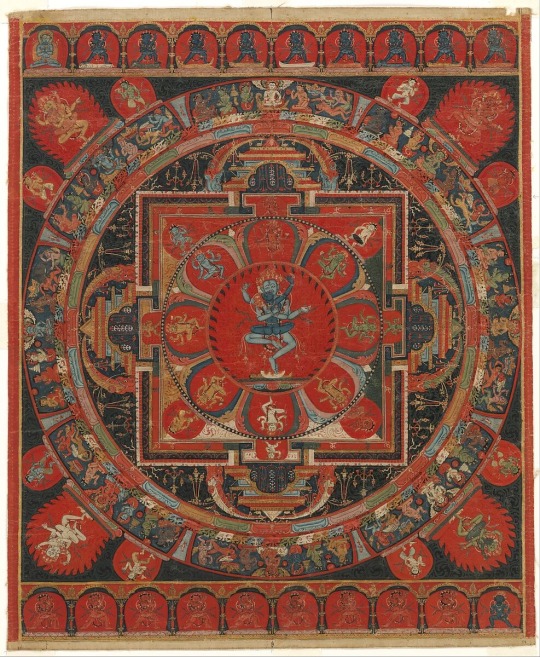
“Hevajra Mandala,” Tibet, 15th century
“Hevajra appears here in his three-headed and four-armed form. This manifestation is drawn from the Hevajra Tantra, a text revered by the Sakya order of Tibetan Buddhism, who likely commissioned this painting from a Newari artist from Nepal. Hevajra and his consort Nairatmya dance at the intersection of four vajra gateways, indicating their position at the center of the cosmos. His name is composed of two syllables: “he,” compassion, representing the male aspect, and “vajra,” wisdom, the female aspect, which together offer the path beyond this illusory world. The repeating skull symbolism references the impermanence of all phenomena. Beyond the celestial palace are the eight great charnel grounds, each presided over by a yogic master, or mahasiddha. On the reverse, in an ornate Tibetan lantsa script, are the Sanskrit mantra oh ah hum and mantra syllables configured in a stupa silhouette.”
-text via The Metropolitan Museum of Art
12 notes
·
View notes
Text
Post 2: The First Steps of Yoga: Stillness and Strength in Practice
“Now, the discipline of yoga begins.”—Patanjali, Yoga Sutra 1.1 With this simple declaration, Patanjali invites us into the present moment. “Atha Yoganushasanam” is a call to awaken to the path of yoga, the path of inner discipline and self-realization. It is a call to begin, no matter where we are in our lives. Yoga, in its deepest sense, is the discipline of mind, body, and spirit—and it…
#ancient yoga philosophy#calming the mind#cessation of mind fluctuations#cultivating stillness#discipline of yoga#inner peace through yoga#inner strength#Meditation practice#mental clarity#mind-body balance#Patanjali Sutra 1.1#Patanjali Sutra 1.2#Patanjali’s teachings#presence in yoga#Raja Yoga#Self-awareness#spiritual discipline#spiritual growth#Swami Vivekananda translation#the path of stillness#Vrittis#yoga for beginners#yoga for mental peace#Yoga Sutras of Patanjali#yogic philosophy#yogic wisdom
0 notes
Text
I will preach this until I am gone from this earth. There is no way to completely rid oneself of one or the other. Balance is the only answer. In my Yogic path I will strive to balance the light and dark within myself and with that find peace and acceptance of self. 🖤🤍
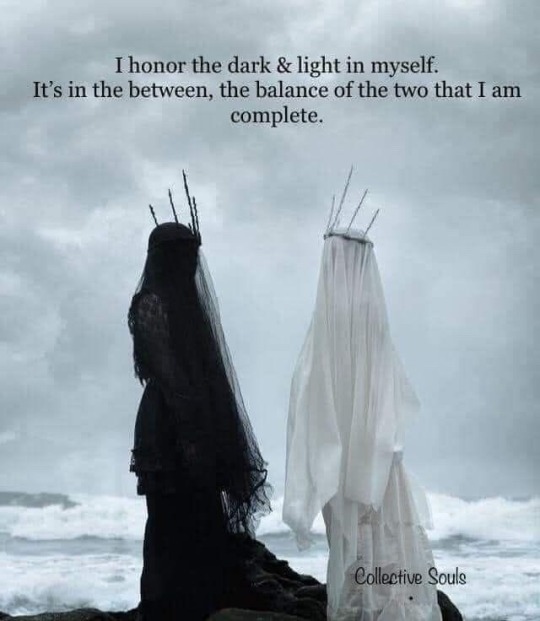
#balance#witchblr#witchcraft#witch community#witchy#witchyvibes#witchlife#witch tips#spiritual#magic#witch#yogiclife#yogicommunity#yogic#spiritual community#spiritual practices#spiritualism#spiritual journey#spiritualgrowth#spiritualpath#spiritual awakening#spirituality#spiritual knowledge#spiritual awareness#spiritualhealing#spiritual vibrations#light and darkness#light and shadow
108 notes
·
View notes